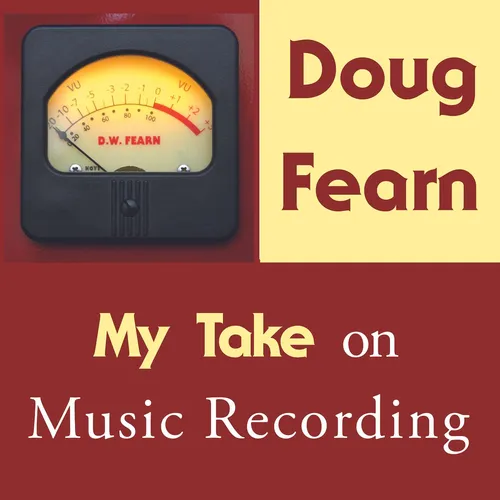
My Take on Music Recording with Doug Fearn
Doug Fearn draws on his 50+ years as a recording engineer, record producer, studio owner, and pro audio equipment designer to explain the art and science of recording for the audiophile, music lover, and people in the music recording industry.
- Update frequency
- every 19 days
- Average duration
- 38 minutes
- Episodes
- 108
- Years Active
- 2020 - 2025

Tracking, Mixing, and Mastering
In the days before tape recording, records had to be made “live,” with the performance going directly to a master lacquer disc. In the 1950s, when recording to tape became possible, the…

Harpischord Recording
In this short episode, I describe the process I went through on a recent recording project. We were recording a harpsichord, an instrument I had some experience recording, but never bef…

Location Recording
Most of us record in studios of various types. But sometimes it is necessary, or advantageous, to record on location.
I’ve had a studio most of my career, but in the early days, I record…

Vacuum Tube Fundamentals
Ever wonder how do vacuum tubes actually work? Tubes are one electronic device that you can actually see how they operate. I explain vacuum tube fundamentals in this conversation with M…

Theater of the Mind
There is a story from the early days of television. A reporter asked a young boy if he preferred to watch a baseball game on TV, or listen to it on the radio.
His answer was immediate. “…

Latency and Delay
We tend to think that electronic signals travel instantaneously, but they do not. They are merely very fast. And the time delay can be perceived by humans under some circumstances.
In t…

Obie O'Brien: A Life In Music -- Part 2
This is the second half of the conversation I had with engineer/producer/mixer/musician/songwriter Obie O’Brien. Obie is best known for his long-time work with Jon Bon Jovi, but as you …

Obie O'Brien: A life in music
Talk about a life in music! Obie O’Brien has done many things in his musical career, starting with playing drums when he was 12, to building a basement studio in the 1960s, to owning a …

Inside the Podcast
As my podcast approaches its one-year anniversary, I look back on what new skills I have had to learn, and share the podcast creation process with you. It’s not a how-to on podcasting, …

Manufacturing Pro Audio Equipment
Manufacturing pro audio equipment was never really part of my plan, but it has become one of the most gratifying aspects of my career in music recording.
It wasn’t until around 2011 when…

Minimalist Mic'ing for Better Sound
Using as few mics as possible on a recording session often leads to better sound for the project. In this episode, I describe how I went from one mic, to many mics, and back to one mic,…

Abbey Road Studios: My three days of recording
I’ve had the privilege to work in some iconic studios, but the one that made the biggest impression on me was Abbey Road in London.
I spent three days doing sessions there, but since I w…

Cables, Connectors, and Studio Wiring
We all need cables and connectors to tie all our mics and other equipment together. There are many places where problems can be introduced into your recording, caused by improper wiring…

Colin Hay, Singer-Songwriter-Recordist
Even if you don’t recognize the name Colin Hay, I guarantee that you have heard him. Colin is best known for his band, “Men At Work,” the Australian group that had #1 hits such as “Down…

34 - All Kinds of Noise
Since the earliest days of sound recording, noise has been a major limitation in audio quality. In early part of my career, tape hiss was usually the biggest challenge. But today’s digi…

33 - All Kinds of Distortion
Distortion is present in all electronic audio equipment and on all recordings. Sometimes it is part of the sound, such as in an electric guitar.
But distortion is usually something we tr…

Disc Cutting
I never did any disc mastering, but I did cut thousands of lacquer discs. I explained how I learned this art, and describe the process of cutting a disc. The medium imposes a lot of res…

31 - My Recording Career, Part 2: From 1973 to 2020
This is a continuation of the story of my recording career, starting where Part 1 (Episode 30) ends in 1973 and covers the following years, up to 2020. During that time, my studio went …

My Recording Career, Part 1: Early influences and first studio
My Recording Career, Part 1: Early influences and first studio
This two-part episode tells the story of my life in recording. It starts out with the musical and electronic experiences th…

The D.W. Fearn VT-7 Compressor
The VT-7 Compressor has an interesting backstory, including a Nashville dinner with my friend, Cranesong’s Dave Hill back in 2003.
In this episode, I tell the story of how the VT-7 came …